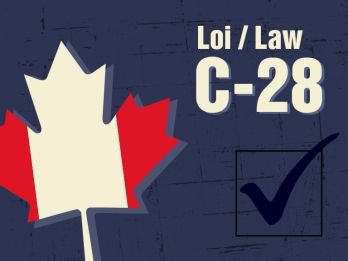Canada’s new Anti-Spam Legislation, how will CASL affect my business?
Wednesday, June 18, 2014, 07:58 PM
Posted by iNewsBLITZ

Canada's new Anti-Spam Legislation comes into effect on July 1st, 2014. We have prepared a quick review of what this will mean for your business commercial electronic communications being sent into Canada.
This document was prepared by Baracci Solutions for information purposes only. For an official version of the Legislation, please visit the website:
www.fightspam.gc.ca
What type of messages does CASL apply to?ANSWER: CASL applies to all commercial electronics message (CEM) sent into Canada. These CEMs are all messages sent electronically with the purpose of encouraging participation in a commercial activity including emails, private social media messages, instant messaging messages and SMS.
When does CASL come into effect?
ANSWER: Most of the CASL regulation (including all email aspects) comes into
effect on July 1st 2014. As of that day, all new contacts located within Canada must be managed as per CASL regulations.
A transitional period of 36 months will be granted for proper management of all existing Canadian contacts (gathered prior to July 1st 2014). During this period, it will be important to get consent from these existing contacts.
After the 36 month transitional period, commercial electronic communication with pre-July 1st 2014 contacts within Canada who have not given their consent will be prohibited by CASL.
Please note that during this grace period, senders must continue to manage existing contacts as per PIPEDA regulations.
What is required in a CEM for compliance?ANSWER: CEMs must contain the following information:
a. Sender’s name
b. Sender’s contact information (P.O. boxes are accepted)
c. Functional & simple unsubscribe mechanism
What does Opt-In mean exactly?
ANSWER: CASL is an opt-in regulation. This means that users must perform an action to Opt-in and be added to your mailing list (as opposed to an Opt-out regulation, such as the CAN-SPAM Act, which forces users take an action if they do not want to be included on your mailing list).
Therefore, checkboxes cannot be pre-checked for the user. The action of giving consent must be left to the user.
Moreover, the Opt-in mechanism must be a standalone field. It cannot be included in other statements such as agreements for terms of use.
How do I get consent?
ANSWER: There must be a clear and precise Opt-in Consent Statement with an action item (check box, link, button). This Consent Statement must clearly identify what users are signing up to. You must enumerate what messages users will be receiving from you once they Opt-in (i.e.: Newsletters, coupons, promotions, surveys).
What are the types of consents?ANSWER: There are two types of consent:
1)Express Consent: When a user takes an action to sign-up to your mailing list, agreeing to receive your CEMs, they are considered as having given you their express consent.
2)Implied Consent: as of July 1st, 2014, if a business relationship exists between the sender and the recipient, implied consent is recognised. The sender is allowed to send CEMs to a recipient for an extended period of 24 months following the end of this business relationship. If the sender has not converted this implied consent into an express consent, he must cease sending CEMs to the recipient.
May I send an email asking for Express Consent?ANSWER: No, sending a message seeking the recipient’s consent to send his CEMs is considered a CEM in itself. Implied consent is therefore required before sending such a message.
Also, it is important to track which type of consent was established and when it was received as the burden of proof will always be on the sender.
When is consent not required?ANSWER: Consent is not required when sending the following types of messages:
1)Quotes or estimates
2)Messages that facilitate or confirm transactions
3)Messages that provide warranty, recall, safety or security information
4)Messages that provide information about ongoing use or ongoing purchases, ongoing subscription, membership, accounts, loans or similar
5)Employment relationships or benefit plans
6)Messages that serve as delivery of a product good or service, including updates and upgrades
What messages are exempt from CASL regulations?ANSWER: There are many types of communications that are not considered CEMs. Here are a few:
1)In response to a request
2)To enforce a legal right or obligation
3)Via closed messaging systems
4)Via proprietary system
5)To a foreign jurisdiction in compliance with their spam law
6)By registered charities raising funds
7)By political candidates or organizations, soliciting political contributions
It is important to note that exempted messages become CEMs when promotional or advertisement banners are added to them.
What are the planned penalties established by CASL?
ANSWER: Firstly, it is important to note that liability will be extended from businesses to directors and officers. The maximum penalty for an individual will be 1 million CAD. The maximum penalty for businesses will be 10 million CAD. This is per violation.
Is this all that I need to know?
ANSWER: No, it is not. This is an abstract as per our interpretation of the law. It is every sender’s responsibility to become familiar with CASL by visiting
www.fightspam.gc.caVisit our Anti-Spam Compliance page :
http://www.inewsblitz.com/anti-spam.html
[ 503 comments ]
( 18742 views )
|
permalink |
related link
 Canada's new Anti-Spam Legislation comes into effect on July 1st, 2014. We have prepared a quick review of what this will mean for your business commercial electronic communications being sent into Canada.
Canada's new Anti-Spam Legislation comes into effect on July 1st, 2014. We have prepared a quick review of what this will mean for your business commercial electronic communications being sent into Canada.